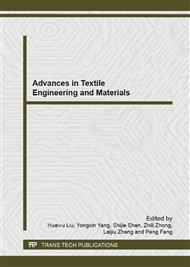p.765
p.770
p.775
p.780
p.785
p.791
p.796
p.800
p.804
Study on Silk Fibroin/ Propylene Glycol Blend Films
Abstract:
Silk fibroin/ propylene glycol blend films were prepared by mixing silk fibroin and propylene glycol (PG) at different ratios. X-ray diffraction and infrared spectroscopy were used to investigate the structure of the blend films, and the results showed that with the content of PG increasing, the structure of the blend films was silkⅠcrystalline structure and then was gradually changed into the crystalline structure of Silk II. The dissolution loss rate was greatly improved, and the transmittance was still kept in good degree. Besides, the blend films had best flexibility when the weight of PG/ SF was 3/10. The fibroblast was culviated on it to evaluate its biocompatibility. The results showed that the blend films could support the attachment and growth of flbroblast cells as a substratum.
Info:
Periodical:
Pages:
785-790
Citation:
Online since:
December 2012
Authors:
Keywords:
Price:
Сopyright:
© 2013 Trans Tech Publications Ltd. All Rights Reserved
Share:
Citation:


